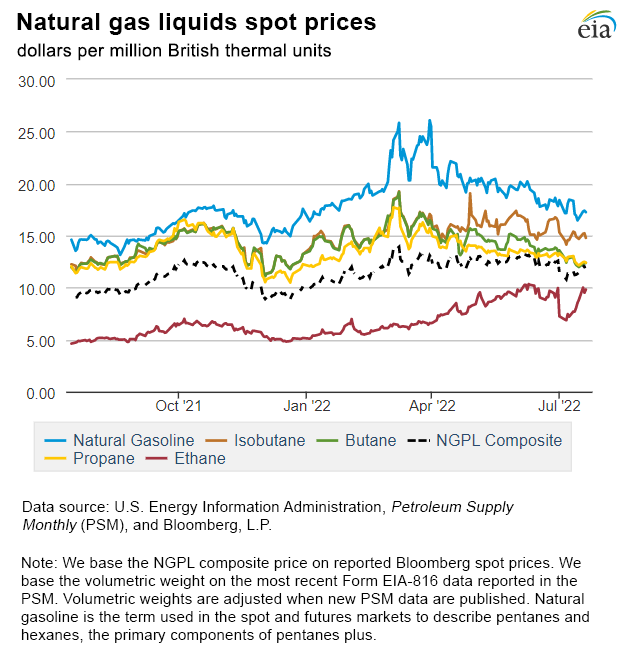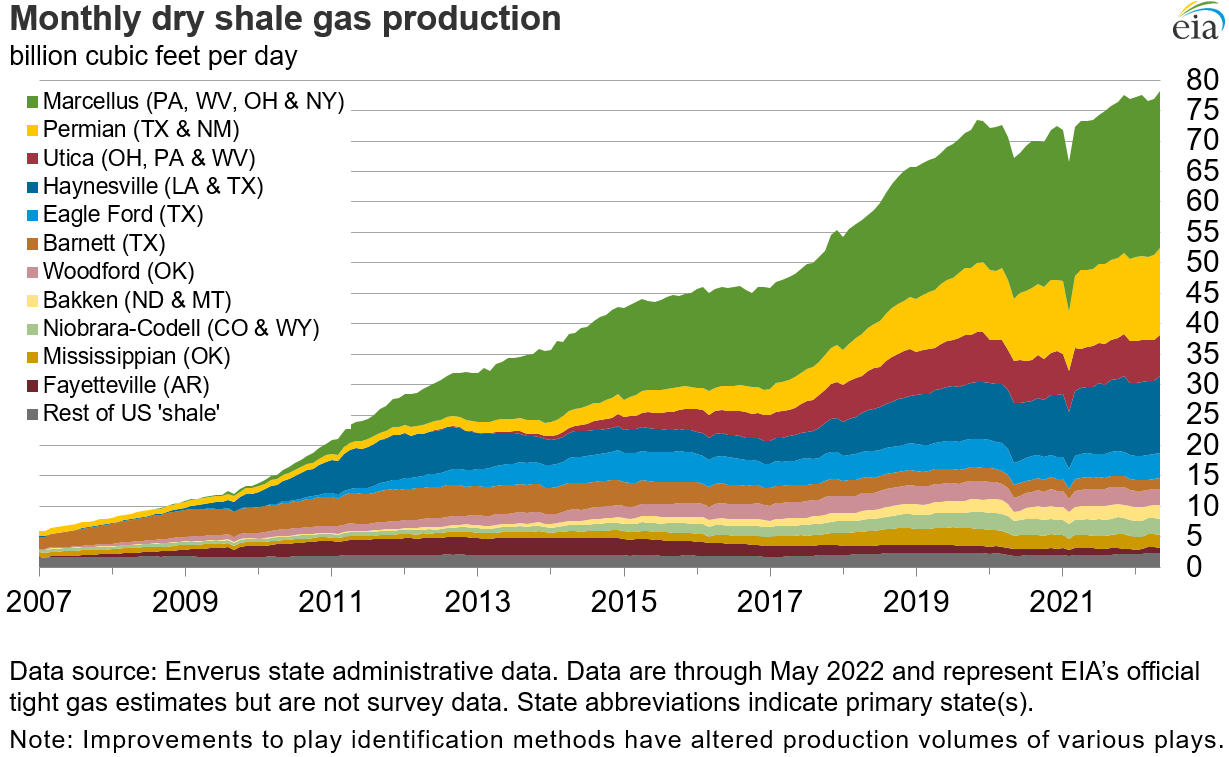In the News:
California’s working natural gas inventories vary by region this summer
Working natural gas inventories of storage fields operated by the two largest natural gas distributors in California—Pacific Gas & Electric (PG&E) in the north and Southern California Gas Company (SoCalGas) in the south—totaled 100.6 billion cubic feet (Bcf) as of June 30, 2022, according to publicly available data. Although this level is 4% higher than year-ago levels, storage operation and capacity utilization varies significantly by region. PG&E’s working natural gas storage capacity accounts for approximately 28% of its system’s working natural gas storage capacity, and merchant facilities account for the remaining capacity. As of June 30, PG&E held 13.0 Bcf of natural gas in storage, about 40% below year-ago levels. In contrast, SoCalGas operates all the storage facilities connected to its distribution network, and working natural gas inventories in those storage fields totaled about 87.6 Bcf on June 30, 17% above year-ago levels.
There are six natural gas storage operators in California, operating fields with a total capacity of 323 Bcf, which represents 88% of the Pacific region’s storage capacity. Working natural gas storage capacity in the Pacific region also includes two facilities in the Pacific Northwest.
Natural gas flows in California from the Pacific Northwest and the Desert Southwest were lower in the first half of 2022. Natural gas pipeline deliveries from the Pacific Northwest into Northern California decreased by 5% compared with the first half of 2021 and deliveries from the Desert Southwest into Southern California declined by 3%, according to data from PointLogic.
Natural gas withdrawals from storage in Northern California were about 125 million cubic feet per day (MMcf/d) higher during November 2021 through March 2022 compared with the same period a year earlier. Despite growing markedly from 4.3 Bcf on March 31 to 14.5 Bcf on July 10, PG&E’s inventories remain 33% less than the year before. PG&E’s working natural gas capacity significantly declined following a June 11, 2021, reclassification of 51.0 Bcf of working gas to base gas as the result of a California Public Utilities Commission (CPUC) Rate Case Final Decision. This change was the largest reclassification in PG&E history. Total PG&E working gas capacity was reduced to 52.5 Bcf as a result of the reclassification.
As of June 30, SoCalGas working gas inventories were 87.6 Bcf, 17% above year-ago levels and 34% above the five-year average. A key factor contributing to Southern California’s higher natural gas inventories was a decision by the CPUC on November 4, 2021, allowing SoCalGas to increase its working gas capacity at the Aliso Canyon Natural Gas Storage Facility to 41.0 Bcf from 34.0 Bcf to help ensure energy reliability in the region. The storage capacity at Aliso Canyon and the ability to store more locally produced natural gas has partially offset reduced natural gas flows into the region since August 2021, following the rupture of Kinder Morgan’s El Paso Natural Gas Pipeline Line 2000.
Market Highlights:
(For the week ending Wednesday, July 20, 2022)Prices
- Henry Hub spot price: The Henry Hub spot price rose from $6.63 per million British thermal units (MMBtu) last Wednesday to $7.56/MMBtu yesterday.
- Henry Hub futures prices: The price of the August 2022 NYMEX contract increased $1.318, from $6.689/MMBtu last Wednesday to $8.007/MMBtu yesterday. The price of the 12-month strip averaging August 2022 through July 2023 futures contracts climbed 91.3 cents to $6.848/MMBtu.
- Select regional spot prices: Natural gas spot prices rose at most locations this report week (Wednesday, July 13, to Wednesday, July 20), and increases at major pricing hubs ranged from 87 cents at PG&E Citygate in Northern California to $17.86 at Algonquin Citygate in the Northeast.
- At the Algonquin Citygate, which serves Boston-area consumers, the price increased $17.86 week over week, from $6.11/MMBtu last Wednesday to $23.97/MMBtu yesterday, after a spike in the price yesterday from Tuesday’s price of $9.37/MMBtu. Temperatures in the Northeast have increased in recent days to above normal, and are expected to remain above normal over the next week. In the Boston Area, the average daily temperature reached 84°F on Wednesday, which is 10°F above normal. To the south, in the New York City Area, the average daily temperature reached 87°F on Wednesday, 9°F above normal. Weekly average natural gas consumption in the electric power sector in the Northeast increased 1.3 billion cubic feet per day (Bcf/d) (13%) week over week. On Tuesday, ISO New England, the Regional Transmission Organization serving the six New England states, reported “Abnormal Conditions” related to the current power system status. EIA’s New England Dashboard provided daily updates to current energy market conditions in the region.
- Prices in California rose this report week, as temperatures across California and the Desert Southwest remained above normal. The price at SoCal Citygate in Southern California increased $1.07 from $7.71/MMBtu last Wednesday to $8.78/MMBtu yesterday. The price at PG&E Citygate in Northern California rose 87 cents, up from $7.62/MMBtu last Wednesday to $8.49/MMBtu yesterday. Natural gas consumption in the electric power sector in California increased by 0.5 Bcf/d (25%) week over week. In the Desert Southwest, the Natural Gas Intelligence El Paso South Mainline/North Baja price rose 99 cents from $7.73/MMBtu last Wednesday to $8.72/MMBtu yesterday. Daily high temperatures in the Phoenix Area were above 110°F for all but one day this report week.
- In the Pacific Northwest, the price at Sumas on the Canada-Washington border rose $1.84 from $5.04/MMBtu last Wednesday to $6.88/MMBtu yesterday, even as total consumption in the Pacific Northwest remained effectively flat this report week. Temperatures in the Seattle City Area averaged 67°F, which is normal for this time of year. Increased production in Canada and increased upstream flow capacity have contributed to the price at Sumas trading at a discount to the Henry Hub spot price in recent weeks. On July 18, Enbridge, the operator of the Westcoast pipeline, which ships natural gas from the production region in northeastern British Columbia to Vancouver and the U.S-Canada border, posted a critical notice (#55977) of pipeline curtailment at Station 4B South, in inland British Columbia, resulting in reduced flows south toward the U.S. border.
- International futures prices: International natural gas futures prices decreased this report week. According to Bloomberg Finance, L.P., weekly average futures prices for liquefied natural gas (LNG) cargoes in East Asia decreased $1.02 to a weekly average of $38.11/MMBtu, and natural gas futures for delivery at the Title Transfer Facility (TTF) in the Netherlands, the most liquid natural gas spot market in Europe, decreased $4.29 to a weekly average of $47.59/MMBtu.
- Natural gas plant liquids prices: The natural gas plant liquids composite price at Mont Belvieu, Texas, rose by 46 cents, averaging $11.78/MMBtu for the week ending July 20. Ethane prices rose 22% to $9.33/MMBtu after falling 17% during the week ending July 6. Despite the natural gas prices at the Houston Ship Channel rising 11%, the ethane premium to natural gas widened by 73% because of the increase in ethane price. The increase in ethane price also narrowed the ethylene to ethane spread by 56% despite the ethylene price rising 2%. The isobutane price remained relatively unchanged along with the Brent crude oil price. Natural gasoline and normal butane prices fell 4%. The propane price fell 3%, increasing the propane discount to crude oil by 7%.
Daily spot prices by region are available on the EIA website.
Supply and Demand
- Supply: According to data from PointLogic, the average total supply of natural gas rose by 0.8% (0.8 Bcf/d) compared with the previous report week. Dry natural gas production grew by 0.6% (0.6 Bcf/d) compared with the previous report week. Average net imports from Canada increased by 3.0% (0.2 Bcf/d) from last week.
- Demand: Total U.S. consumption of natural gas rose by 2.9% (2.1 Bcf/d) compared with the previous report week, according to data from PointLogic. Natural gas consumed for power generation climbed by 3.9% (1.6 Bcf/d) week over week. Industrial sector consumption increased by 0.8% (0.2 Bcf/d). In the residential and commercial sectors, consumption increased by 3.5% (0.3 Bcf/d). Natural gas exports to Mexico increased 2.3% (0.1 Bcf/d). Natural gas deliveries to U.S. LNG export facilities (LNG pipeline receipts) averaged 10.9 Bcf/d, or 0.2 Bcf/d lower than last week.
Liquefied Natural Gas (LNG)
- Pipeline receipts: Natural gas deliveries to LNG export terminals in South Louisiana decreased by 0.2 Bcf/d (3%) this report week, while deliveries to all other export terminals were effectively flat. Natural gas deliveries to all U.S. LNG export terminals declined by 0.2 Bcf/d (2%) week over week to 10.9 Bcf/d. At Calcasieu Pass in Cameron Parish, Louisiana, feedgas deliveries declined by 0.2 Bcf/d week over week, according to data from PointLogic.
- Vessels departing U.S. ports: Sixteen LNG vessels (eight from Sabine Pass, four from Corpus Christi, two from Cameron, and one each from Calcasieu Pass and Cove Point), with a combined LNG-carrying capacity of 61 Bcf, departed the United States between July 14 and July 20 according to shipping data provided by Bloomberg Finance, L.P.
- LNG import terminals: An LNG vessel discharged a cargo of approximately 3 Bcf at the Everett LNG Facility, near Boston, Massachusetts, operated by Constellation, according to shipping data provided by Bloomberg Finance, L.P.
Rig Count
- According to Baker Hughes, for the week ending Tuesday, July 13, the natural gas rig count was unchanged from a week ago at 153 rigs. The number of oil-directed rigs increased by 2 rigs to 599 rigs. The Granite Wash added two rigs, one rig was added in an unspecified producing region, and the Permian Basin dropped one rig. Two rigs were added in the miscellaneous (non-oil or natural gas) category, and the total rig count now stands at 756 rigs.
Storage
- Net injections into storage totaled 32 Bcf for the week ending July 15, compared with the five-year (2017–2021) average net injections of 41 Bcf and last year's net injections of 50 Bcf during the same week. Working natural gas stocks totaled 2,401 Bcf, which is 328 Bcf (12%) lower than the five-year average and 270 Bcf (10%) lower than last year at this time.
- According to The Desk survey of natural gas analysts, estimates of the weekly net change to working natural gas stocks ranged from net injections of 34 Bcf to 59 Bcf, with a median estimate of 41 Bcf.
- The average rate of injections into storage is 5% lower than the five-year average so far in the refill season (April through October). If the rate of injections into storage matched the five-year average of 8.5 Bcf/d for the remainder of the refill season, the total inventory would be 3,317 Bcf on October 31, which is 328 Bcf lower than the five-year average of 3,645 Bcf for that time of year.
Other Market Drivers
- Tennessee Gas Pipeline (TGP) announced force majeure on two pipeline segments, both beginning last Thursday (July 13), reducing southbound flows by approximately 125 million cubic feet per day (MMcf/d) in Pennsylvania, and reducing flows by approximately 200 MMcf/d in Alabama. The force majeure in Alabama was lifted on July 16.
See also:
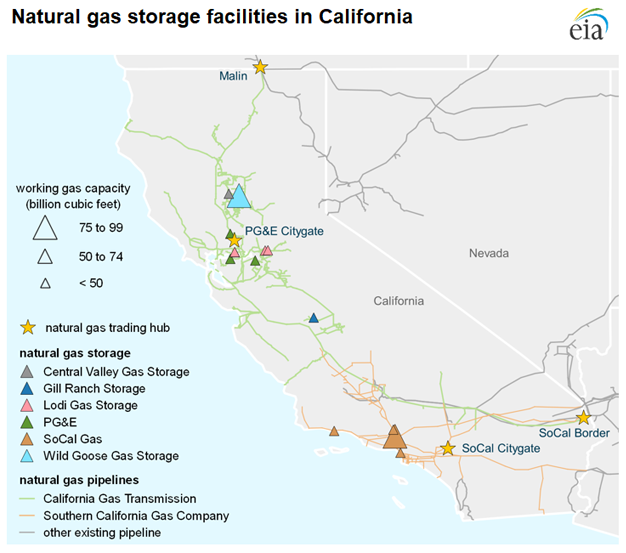 Data source: U.S. Energy Information Administration, Form EIA-191, Monthly Underground Natural Gas Storage Report, December 2021
Data source: U.S. Energy Information Administration, Form EIA-191, Monthly Underground Natural Gas Storage Report, December 2021
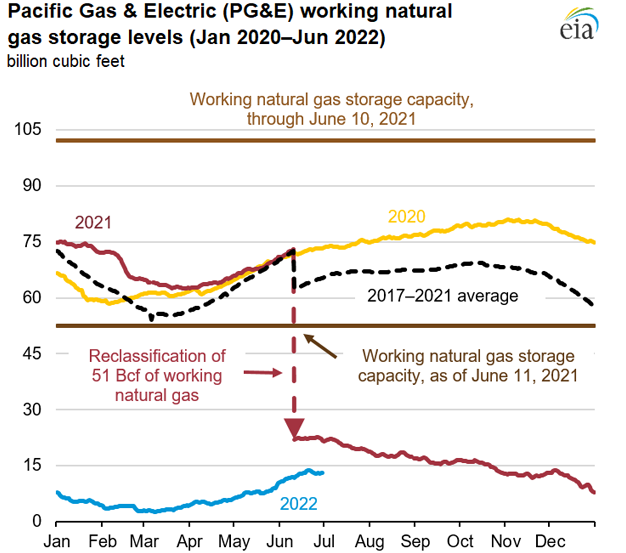 Data source: PG&E, California Gas Transmission
Data source: PG&E, California Gas Transmission
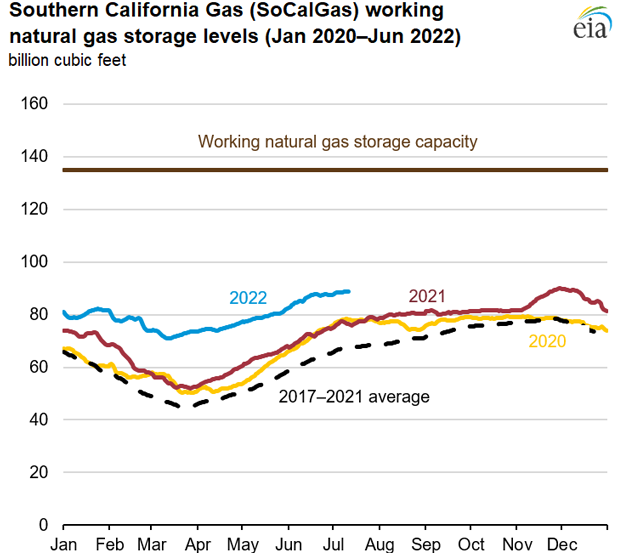 Data source: SoCalGas, SoCalGas Envoy
Data source: SoCalGas, SoCalGas Envoy
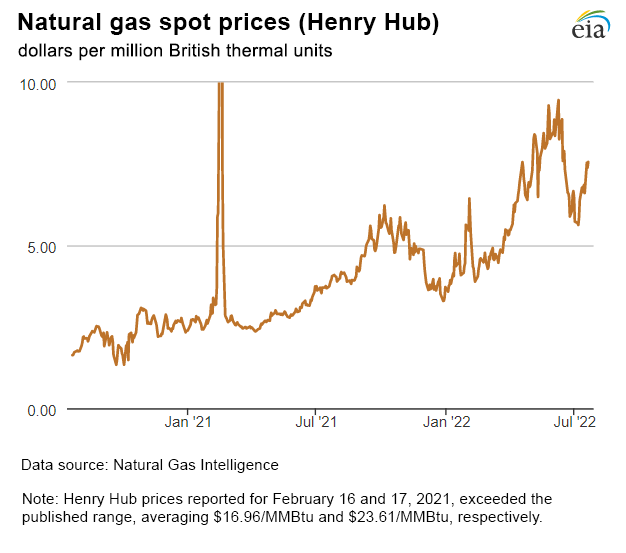
| Spot Prices ($/MMBtu) | Thu, 14-Jul |
Fri, 15-Jul |
Mon, 18-Jul |
Tue, 19-Jul |
Wed, 20-Jul |
|---|---|---|---|---|---|
| Henry Hub |
6.86 |
6.61 |
7.54 |
7.39 |
7.56 |
| New York |
6.03 |
6.10 |
7.76 |
8.92 |
8.28 |
| Chicago |
6.60 |
6.49 |
7.35 |
7.19 |
7.44 |
| Cal. Comp. Avg.* |
7.35 |
7.08 |
8.08 |
8.12 |
8.13 |
| Futures ($/MMBtu) | |||||
| August contract | 6.600 |
7.016 |
7.479 |
7.264 |
8.007 |
| September contract |
6.511 |
6.926 |
7.382 |
7.150 |
7.899 |
| Data source: Natural Gas Intelligence and CME Group as compiled by Bloomberg, L.P. *Avg. of NGI's reported prices for: Malin, PG&E Citygate, and Southern California Border Avg. |
|||||
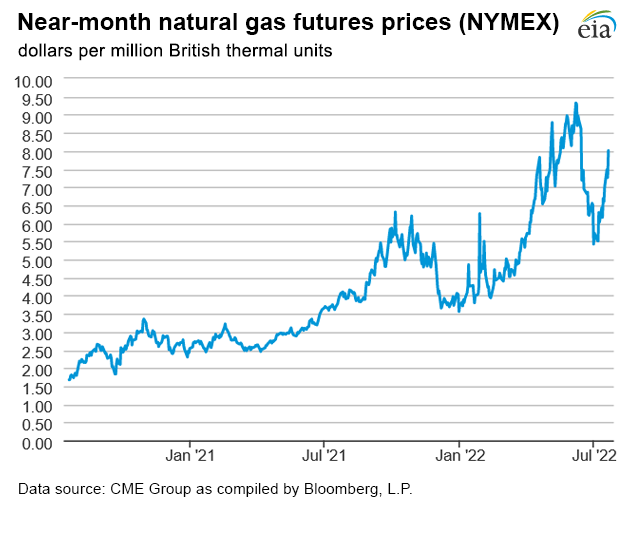
| U.S. natural gas supply - Gas Week: (7/14/22 - 7/20/22) | |||
|---|---|---|---|
Average daily values (billion cubic feet) |
|||
this week |
last week |
last year |
|
| Marketed production | 108.7 |
108.1 |
105.9 |
| Dry production | 96.6 |
96.0 |
93.2 |
| Net Canada imports | 6.0 |
5.9 |
5.0 |
| LNG pipeline deliveries | 0.1 |
0.1 |
0.1 |
| Total supply | 102.7 |
102.0 |
98.3 |
|
Data source: PointLogic | |||
| U.S. natural gas consumption - Gas Week: (7/14/22 - 7/20/22) | |||
|---|---|---|---|
Average daily values (billion cubic feet) |
|||
this week |
last week |
last year |
|
| U.S. consumption | 74.0 |
71.9 |
69.2 |
| Power | 43.4 |
41.7 |
39.8 |
| Industrial | 21.0 |
20.9 |
21.3 |
| Residential/commercial | 9.6 |
9.3 |
8.1 |
| Mexico exports | 6.1 |
6.0 |
6.3 |
| Pipeline fuel use/losses | 6.7 |
6.7 |
6.4 |
| LNG pipeline receipts | 10.9 |
11.1 |
10.8 |
| Total demand | 97.7 |
95.6 |
92.6 |
|
Data source: PointLogic | |||
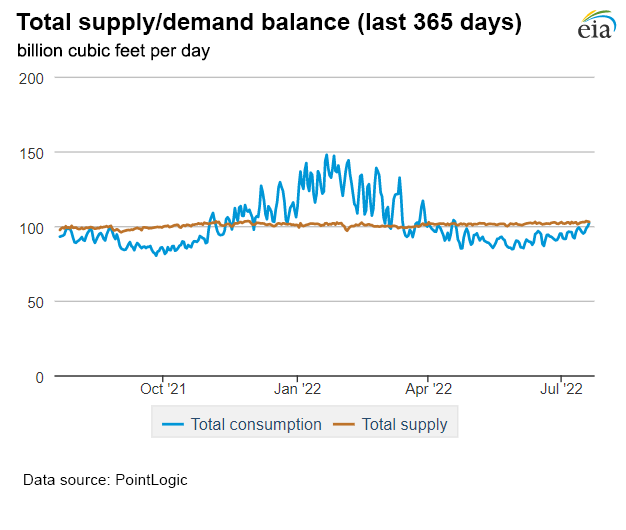
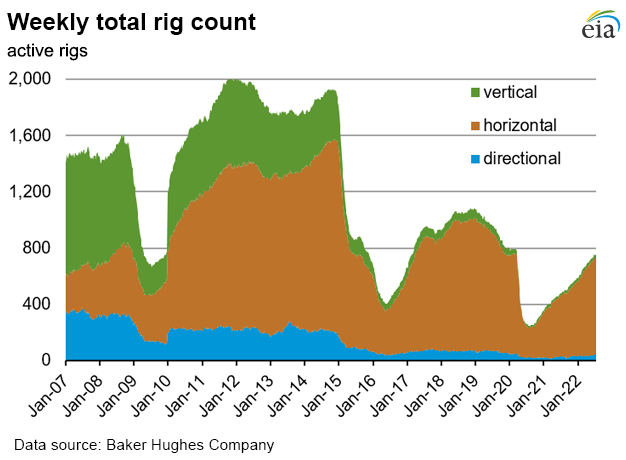
| Rigs | |||
|---|---|---|---|
Tue, July 12, 2022 |
Change from |
||
last week |
last year |
||
| Oil rigs | 599 |
0.3% |
57.6% |
| Natural gas rigs | 153 |
0.0% |
47.1% |
| Note: Excludes any miscellaneous rigs | |||
| Rig numbers by type | |||
|---|---|---|---|
Tue, July 12, 2022 |
Change from |
||
last week |
last year |
||
| Vertical | 30 |
11.1% |
66.7% |
| Horizontal | 686 |
0.6% |
58.1% |
| Directional | 40 |
-7.0% |
25.0% |
| Data source: Baker Hughes Company | |||
| Working gas in underground storage | ||||
|---|---|---|---|---|
Stocks billion cubic feet (Bcf) |
||||
| Region | 2022-07-15 |
2022-07-08 |
change |
|
| East | 521 |
501 |
20 |
|
| Midwest | 608 |
586 |
22 |
|
| Mountain | 144 |
143 |
1 |
|
| Pacific | 253 |
249 |
4 |
|
| South Central | 874 |
890 |
-16 |
|
| Total | 2,401 |
2,369 |
32 |
|
| Data source: U.S. Energy Information Administration Form EIA-912, Weekly Underground Natural Gas Storage Report | ||||
| Working gas in underground storage | |||||
|---|---|---|---|---|---|
Historical comparisons |
|||||
Year ago (7/15/21) |
5-year average (2017-2021) |
||||
| Region | Stocks (Bcf) |
% change |
Stocks (Bcf) |
% change |
|
| East | 559 |
-6.8 |
587 |
-11.2 |
|
| Midwest | 680 |
-10.6 |
671 |
-9.4 |
|
| Mountain | 183 |
-21.3 |
172 |
-16.3 |
|
| Pacific | 247 |
2.4 |
276 |
-8.3 |
|
| South Central | 1,001 |
-12.7 |
1,023 |
-14.6 |
|
| Total | 2,671 |
-10.1 |
2,729 |
-12.0 |
|
| Data source: U.S. Energy Information Administration Form EIA-912, Weekly Underground Natural Gas Storage Report | |||||
| Temperature – heating & cooling degree days (week ending Jul 14) | ||||||||
|---|---|---|---|---|---|---|---|---|
HDDs |
CDDs |
|||||||
| Region | Current total |
Deviation from normal |
Deviation from last year |
Current total |
Deviation from normal |
Deviation from last year |
||
| New England | 2 |
1 |
0 |
42 |
2 |
13 |
||
| Middle Atlantic | 0 |
0 |
0 |
58 |
3 |
-8 |
||
| E N Central | 1 |
0 |
-5 |
46 |
-9 |
5 |
||
| W N Central | 0 |
-3 |
-3 |
74 |
5 |
23 |
||
| South Atlantic | 0 |
0 |
0 |
94 |
-2 |
-7 |
||
| E S Central | 0 |
0 |
0 |
100 |
7 |
10 |
||
| W S Central | 0 |
0 |
0 |
153 |
31 |
46 |
||
| Mountain | 0 |
-6 |
0 |
99 |
22 |
-2 |
||
| Pacific | 0 |
-4 |
0 |
52 |
12 |
-22 |
||
| United States | 0 |
-1 |
-1 |
78 |
6 |
3 |
||
|
Data source: National Oceanic and Atmospheric Administration Note: HDDs=heating degree days; CDDs=cooling degree days | ||||||||
Average temperature (°F)
7-day mean ending Jul 14, 2022
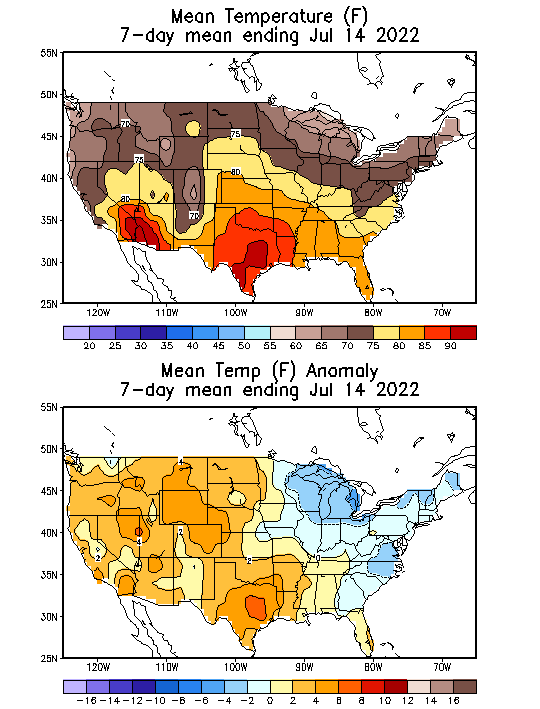
Data source: National Oceanic and Atmospheric Administration
Deviation between average and normal temperature (°F)
7-day mean ending Jul 14, 2022

Data source: National Oceanic and Atmospheric Administration

